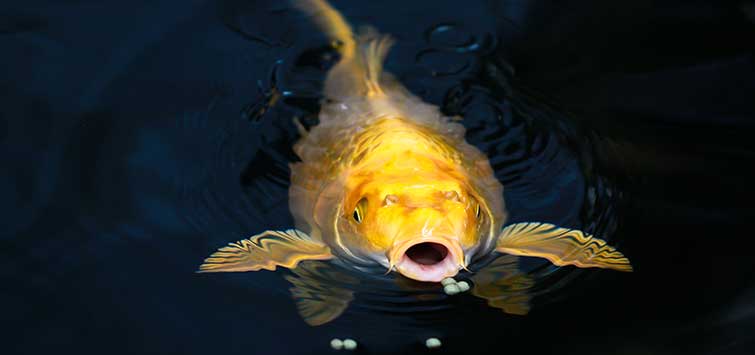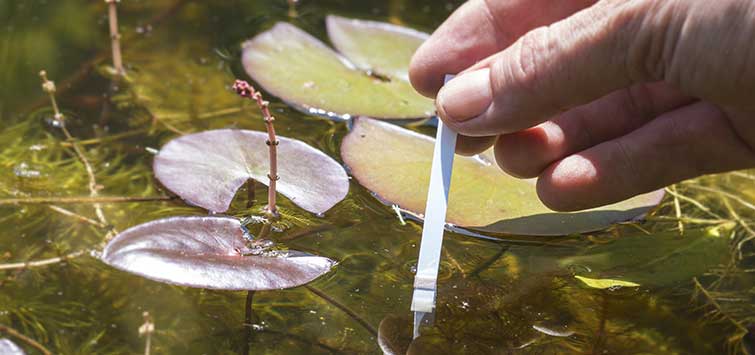The Skeptical Fishkeeper: Spring Ponds 2: The Good, the Bad, and the Ugly
Author: Laura Muha
In last month’s column, I described the first half of a day that I spent with Dr. Julius Tepper, a Long Island veterinarian known as “pond doc” to his clients. My goal was to figure out the best way to get my pond up and running for the spring, a time when fluctuating temperatures and weird weather cause shifts in water conditions that can put fish at risk.
The first pond we visited, which I described last month, was in excellent shape. But not all pondkeepers take such good care of their systems, as I discovered when we pulled into the driveway of another home about 20 minutes away. These owners—who shall remain nameless to protect the guilty—had called Tepper because one of their koi had developed a lesion near its eye.
Problems Galore
Although the owners described the situation as urgent, neither was around when we arrived. We reached the wife on her cell phone, and she said she had decided at the last minute to get her nails done but that we should go ahead and look at the pond anyway. So, nets and water test kits in hand, we walked around to the patio, where an above-ground pond had been built into the retaining wall. It was an attractive setup, but one glance at the two massive koi swimming in agitated circles within its 5- x 8-foot confines was all it took to see that the pond was in trouble.
“In my experience, the more beautifully landscaped ponds seem to be the ones that have the most problems,” Tepper said with a sigh. Not that a pond can’t be beautifully landscaped and healthy, he added; it’s just that when homeowners plan ponds around aesthetics without taking into account the long-term needs of the fish, problems almost inevitably occur somewhere down the line.
That was certainly true in this case. Tepper had not been surprised by today’s emergency, because it wasn’t the first such visit he’d made to this pond. In fact, he’d been there only three weeks earlier, when the frantic owners called to say that one of their koi was lying motionless on its side on the bottom of the pond.
Tepper’s Findings
When Tepper arrived for that visit, he quickly realized that the problem was due to cold shock. After an unusually mild spell, the temperature had suddenly plunged back into the teens—a see-sawing of the mercury that’s not uncommon at this time of year in the Northeast. The owners had already started their waterfall for the season, something Tepper doesn’t advise doing until the temperature reaches 60°F, because as the water splashes over the rocks its temperature tends to change quickly in accordance with that of the air.
In this case, the water temperature had dropped so fast that the koi couldn’t handle it—something the homeowners could have prevented either by leaving the waterfall off until the air grew consistently warmer, or by turning it on during the heat of the day and off again at night as the air grew cooler. Fortunately the fish did recover, but Tepper warned the homeowners that the incident had almost certainly compromised the fish’s immune system, which at this time of year is suppressed to begin with, so more problems were likely to occur. Now, three weeks later, they had.
“I’m starting to look clairvoyant to these people,” Tepper joked. He dipped a net into the pond and used it to guide the fish into a soft black fabric koi sock. Pulling it to the surface, he peeled the sock back to reveal a gaping sore along the rim of its eye. “That’s a nasty infection,” Tepper said. “I think what we’re dealing with is an ulcer but it’s very close to the eye.” Fortunately, the owners had noticed it early, so with antibiotics the koi would probably recover. But the more troubling issue, he said, was how to get them to make changes that would prevent such problems in the future.
A Management Problem
Tepper pointed out dozens of koi pellets bobbing like buoys on the surface of the water. “Uneaten food!” he said. “Whenever I see food floating around like that, I know that there’s a management problem.”
And then there was the algae, which typically doesn’t become problematic in this part of the country until the water gets considerably warmer, but which was already getting out of control in this pond. “That’s because the nutrient level is so rich,” Tepper said.
Bioload Trouble
He blamed not only the extra food, but also the bioload created by the two gigantic koi in a mere 600 gallons of water. While that stocking density might seem appropriate—a frequent recommendation for koi is 300 gallons per adult koi—that’s actually deceiving, because 600 gallons of water doesn’t provide sufficient swimming room for two fish that are the size of large dachshunds. Tepper said that based on his experience, 1000 gallons is the bare minimum for a healthy koi pond, and those 1000 gallons should be home to no more than three adult koi. That stocking density, he explained, builds enough of a margin of error into the system that it can absorb many of the environmental fluctuations to which outdoor systems are subject. “Beyond that, you’re going to have to depend on technology to keep the fish healthy, and technology can be unreliable,” Tepper explained.
That doesn’t mean, however, that the owners have to re-dig their pond. Instead, he said, they could solve their problems by swapping out their koi for a few goldfish, which don’t grow as big as koi and therefore need less space, or by adding a sump to the system. While the latter wouldn’t give the koi more swimming room, it at least would increase the volume of water in the system, improving water quality without requiring the homeowners to alter their attractive setup.
However, Tepper also knows from experience that many clients are resistant to such suggestions, stubbornly insisting that there’s no reason to change anything because what they’ve been doing has worked in the past. What they fail to realize, he said, is that often it worked because the fish were small. But as they grew, the pressure they placed on the system increased as well, making it dangerously unstable.
Water Changes
Since the homeowners with the sick koi had not implemented Tepper’s suggestions to downsize their fish or enlarge their system, he said he’d encourage them to do the one other thing that would help reduce the bioload: more water changes. “A couple bottles of dechlorinator is all they would have to buy, and I think it would really help these fish out a lot,” Tepper said. But he wasn’t optimistic the homeowners would take his advice. “Sometimes, it takes all my skills professionally and diplomatically to deal with situations like this, and I’m not always successful,” he said.
Saving Louis
When he does convince homeowners to make changes in their setups, however, the result can be a dramatic improvement in the health of the pond and its inhabitants—something I witnessed when we visited another pond on that day’s schedule. Like the house with the sick koi, these owners had designed their 2500-gallon pond with aesthetics in mind; long and rectangular, it was set into their wooden deck, with a Japanese-style pergola over it and a lovely Japanese-style garden behind it. It was stunning, but, like the previous pond, it was also a mess the first time Tepper saw it a couple of years ago.
The owners had called him for a consultation on “Louis,” their favorite koi, whose mouth was so badly infected that he couldn’t eat. It didn’t take Tepper long to figure out that the fish’s problem had its roots in the pond’s massive design flaws. For instance, the waterfall was at the deep end instead of at the shallow end. That set up an odd water-circulation pattern that left dead spots in the middle of the pond. The water there got very warm as well, which led to a bacterial explosion and contributed to Louis’s infected mouth.
But now, Tepper said proudly, both the pond and Louis were the picture of health. The owners had moved the waterfall to the shallow end of the pond, setting up good circulation of the water in the pond and improving oxygenation. They’d also, at Tepper’s urging, added a 1200-gallon sump to the system to increase its volume. And, while water plants didn’t fit with the design of their main pond, they added dozens of them to sump, which helped pull organics from the system and significantly improved the water quality.
And 10-year-old Louis? Tepper had successfully treated him with injectable antibiotics, and he was clearly the star of the show, rushing over and practically wagging with excitement when he saw us at the edge of the pond. “Here’s my buddy!” said Tepper, delighted to see the fish. “He’s the first one up to eat now!”
Spring Checkup
The point of the day’s visit, however, wasn’t to socialize with Louis—it was to give the pond a spring checkup, so Tepper got to work. He did a series of water tests to verify that the organic load of the pond wasn’t getting too heavy (it wasn’t), then pulled out a net and prepared to capture one of the fish for a parasite check, which he likes to do at least once a year in clients’ ponds. “The ideal situation would be to check every fish [from] stem to stern, but that’s just not practical,” he said.
Instead, he usually tests one fish from a pond, something that is often enough to identify potential problems before they become apparent enough to spot them with the naked eye, by which time there is often some fish mortality. The day before, for instance, he’d pulled a test fish from another client’s pond and discovered that it was covered with flukes. “That just floored me,” Tepper said, because to the naked eye, the fish in the pond looked perfectly healthy.
Now, he ran a seine net across the pond to herd Louis and his pondmates to one end of the pond, then dipped his net into the water and pulled out a black “koimet”—a hybrid of a goldfish and koi that often result when koi and goldfish are kept together. (“Another reason koi ponds should only contain koi,” Tepper said.)
The koimet splashed frantically as Tepper dropped it into a plastic bucket of water and added anesthesia. When the fish was sedated, he pulled it out of the water just long enough to snip samples of its gills and fins, and scrape some mucous from its scales. Then he put the fish back in the bucket and peered at the samples under the microscope he’d brought with him.
“No parasites,” he reported to the owner, who walked in just as he was finishing up.
“How about baking soda?” she asked, noting that the alkalinity of the water sometimes got a bit low.
Tepper nodded. The buffering capacity of Long Island water tends to be low, and once it was depleted, the respiration of the algae that was starting to grow in the pond could cause the pH of the water to swing and stress the fish.
“Baking soda wouldn’t hurt,” he said, “but do your water change first.”
And with that always-sound advice, he packed up his SUV and headed off to the next pond.

.png?h=595&iar=0&w=2781&hash=5FD5E69473BCC22199FBFA2FB71B6033)



